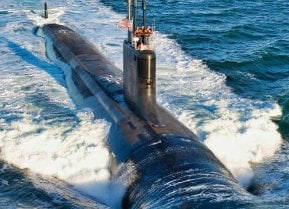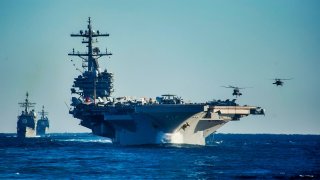The U.S. Navy's Aircraft Carrier Dominance Could Go Up in Flames
Whether it is the Nimitz-class or the Ford-class carriers, the fact remains that these systems are the most prominent warship on the high seas today. But they are now obsolete.
Summary: In 2018, a retired US Navy captain predicted a grim future for America's aircraft carriers, asserting that the US Navy's dependence on these vessels could lead to a significant loss in combat, especially given China's advancements in anti-access/area denial (A2/AD) capabilities. As of 2024, this prediction seems increasingly plausible. Aircraft carriers, long seen as symbols of US military supremacy, are vulnerable to China's A2/AD systems designed to counteract US power projection. With the US already facing global military challenges and a shift in warfare technology, the loss of an aircraft carrier could limit US military response options and necessitate a strategic pivot towards developing weapons capable of countering A2/AD threats. This scenario underscores the need for the US Navy to adapt to modern warfare dynamics and reconsider its reliance on aircraft carriers as primary assets.
The Vulnerable Giants: Are US Aircraft Carriers Becoming Obsolete in Modern Warfare?
“The only way the US Navy divorces itself from the aircraft carrier cult is if it loses one in combat…which it’s going to, very soon, if things keep going at this rate.” Those prophetic words were spoken to me by a retired US Navy captain (and former neighbor of mine) way back in 2018. Back then, I assumed that he was just being the old codger he’d always presented himself as.
Now, in 2024, he seems correct in his assessment.
And what a feather in the cap it’ll be for any Chinese missile battery commander who manages to either sink or disable the flight deck of one of America’s carriers.
Aircraft Carrier Drama: What is a Flat Top Next to Victory?
The aircraft carrier is, without a doubt, the greatest symbol of US military power to date. Able to travel anywhere on the high seas, making port calls along the way, these floating airbases are continual reminders of the potency—and investment into—military dominance that the US government has made over the years.
Most of America’s aircraft carrier fleet are comprised of the Nimitz-class, with the new Ford-class being the replacement for these systems (though it remains to be seen if the Navy will actually be able to completely replace the Nimitz-class, due to the costs of the Ford-class carriers).
Whether it is the Nimitz-class or the Ford-class carriers, the fact remains that these systems are the most prominent warship on the high seas today.
Carrying dozens of potent warplanes, reconnaissance aircraft, and possessing a suite of other important military capabilities, the aircraft carrier is America’s most prominent power projection platform. And since the United States is physically so much farther away from the territories of its rivals, the US military requiresoffensive power projection systems.
To overcome the threat that America’s flat tops pose to them, the Chinese military has built a stunning array of what’s known as anti-access/area denial (A2/AD) weapons. These capabilities are specifically tailored to stunting the power projection potential of US aircraft carriers. Knowing how symbolic these weapons platforms are for the American psyche, as well as how expensive they are, Beijing has surmised that knocking these behemoths out in combat would prove so destructive to any American war effort against China, that Washington might sue for peace with China rather than risk a wider war.
Just How Could the US Retaliate If Its Aircraft Carriers Were Knocked Out?
Many reading this are incredulous about that notion. After all, US aircraft carriers are not only wildly expensive platforms with countless important other equipment aboard, but they are staffed by thousands of American sailors. If China got in a lucky shot and either sank or disabled a flat top, surely the Americans would “bring down the wrath of God” upon the Chinese, just as Uncle Sam did against Japan in the Second World War and against al Qaeda following 9/11.
In the first case, the United States was a dominant manufacturing power that could truly be the “arsenal of democracy.” Losing ships in combat, as the US did in WWII, was not as catastrophic as today. In the second case, despite the speedy retaliation US forces engaged in after 9/11, ultimately, the United States lost the Global War on Terror.
Since the War on Terror ended, the United States has found itself mired in a losing war in Ukraine. It is being challenged by petty tyrants from Iran to North Korea to Venezuela. Rag-tag insurgents, like the Houthi Rebels, are holding US power hostage in the Red Sea and Strait of Bab El-Mandeb.
So, it is not entirely unbelievable that a near-peer competitor, like China, with its superiority in A2/AD systems or hypersonic weapons, could conceivably knock out an American carrier.
Once that sad event occurs, just how would the US retaliate? Would Washington escalate to nuclear warfare? Would they attempt to bomb China directly?
The point is that, once the carriers are removed as the primary weapon system for the Navy, given how much the Navy has invested in its carriers, there will be both a limit to how the military could respond to a Chinese A2/AD attack as well as a degree of reticence.
Likely, submarines would have to become a better power projection platform. But the Navy would have to be willing to lose a high number of these in combat. The defense industrial base is already having problems meeting increased demand for more submarines. In a wartime environment, this could be catastrophic.
The Real Pathway Forward: Build Anti-A2/AD
Clearly, the aircraft carrier has become as useless to modern warfare as the battleship became when the Second World War broke out. Recognizing this problem now, rather than waiting for hostilities to erupt, would be the first necessary step for the Navy to avert the calamity of losing one of its flat tops to China’s A2/AD systems.
Rather than continuing spending exorbitant sums of tax dollars on a wasting asset, like the aircraft carrier, why not redirect those funds into weapons that can overwhelm the A2/AD capabilities of China? Once those A2/AD systems were neutralized, then, the Navy could bring its flat tops into the fight.
As it stands now, however, the aircraft carrier is going to get destroyed and usher in America’s defeat by China’s A2/AD.
About the Author
Brandon J. Weichert is a former Congressional staffer and geopolitical analyst who is a contributor at The Washington Times, as well as at American Greatness and the Asia Times. He is the author of Winning Space: How America Remains a Superpower (Republic Book Publishers), Biohacked: China’s Race to Control Life, and The Shadow War: Iran’s Quest for Supremacy. Weichert can be followed via Twitter @WeTheBrandon.


